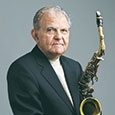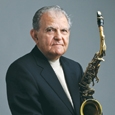There is a big difference when listening to a student improvise over chord changes compared to a solo by a more experienced player. A student manufactures a melodic improvised line and hears it after it is executed on the instrument. A pro hears an improvised line in the mind first and plays what is heard. The instrument is a tool to amplify the mental concept so it can be heard by the listener. Developing this skill requires several steps.
First, encourage students to listen to many recordings by such jazz legends as Sonny Stitt, Lester Young, Phil Woods, James Moody, Clifford Brown, Art Farmer, Bill Evans, Herbie Hancock, Ella Fitzgerald, J.J. Johnson, and many others. Extensive listening helps students begin to hear and learn the jazz language. As with any new language, the more you hear it, the better you learn to use it.
It is especially useful to begin transcribing jazz solos to analyze the language of these players. A teacher cannot plant great jazz phrases in students’ heads but can only help them play what they already hear. Careful listening to professional jazz players vastly increases the range of melodic improvised lines in the mind. By listening to and copying solos, the ability to hear melodic content develops as opposed to isolated notes. The notes in a melody are not only associated with other notes in a phrase, but also share a direct relationship with the harmonic structure of that phrase as in the common progression of Dm7, G7, CMaj7.
Initially, it is more important for students to be able to sing a professional solo than it is to play it on the instrument. This does not require excellent vocal skills. Sung pitches may sound incorrect, but the correct pitches will be heard in the mind. Singing takes away the instrument and offers the freedom and ease of articulating the solo. By singing these solos students will begin to learn and feel the flow of the melodic line and realize that each line contains peak tones (special important notes) that give the line motion.
Start by having them sing a simple phrase fragment and then try to find and play the notes on the instrument.

Then lengthen the phrase and first sing and then try to play the notes as shown in the following examples.
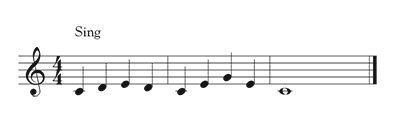
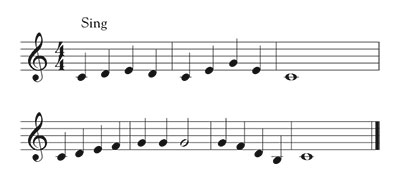
They should continue to sing short melodies of their own and then play what they sang.
Students need to be able to play not only what they hear but also develop the ability to remember longer phrases. This takes patient practice over many hours and weeks, but will prove well worth the time as they develop improvisational skills. They do not need to know the names of the notes they hear, only the sequence of the sounds to be played.
The next step is to transfer the knowledge of what is heard in the mind to playing these phrase fragments over chord changes. Take a typical C major jazz chord progression – dm7, G7, C Major. The Dm7 is a minor (Dorian) sound, the G7 is a dominant sound, and, of course, the C is major. Help students hear the quality of these chord changes by playing the corresponding scale and arpeggio for each chord. This exercise is essential because the arpeggio and scale of each chord will give all the appropriate notes to use for an improvised line for each chord.
Dm7 Arpeggio and Scale


G7 Arpeggio and Scale

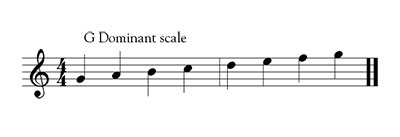
C Major Arpeggio and Scale

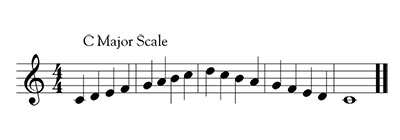
Analysis of the scales for each chord will illustrate that it is basically the same scale starting on a different note each time.
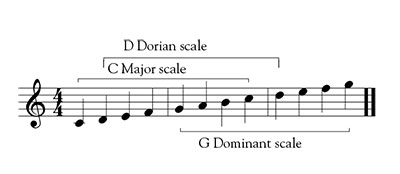
The difference in the sound of each chord comes from the 3rd and 7th.

In the D Dorian scale, the 6th note B contributes to the Dorian quality.

Because these are the peak tones (3rd, 7th, 6th) of each cord, learn to sing and hear what they sound like over the ii7, V7, I chord progression.
Begin by singing the 3rd of each chord.
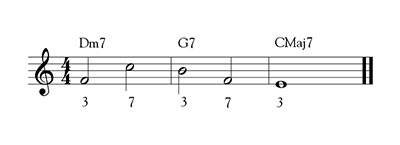
Then sing only the 7th of each chord.

Next, listen to how the 3rd and 7th of each chord sound.
.jpg)
Now, this begins to sound more like a melodic line. By adding a few more scale tones, the phrase takes on more melodic content.
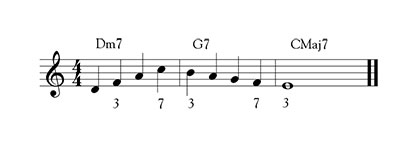
or
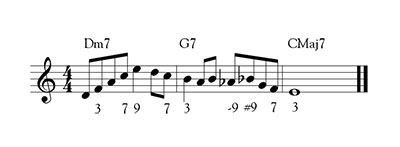
As students develop an understanding of how these notes in the above exercises are used and their relationship to the chords and melodic line, they should continue to sing and play them with a play-along recording. These peak tones define the quality of the melodic line.
There are many play-along recordings for developing the ear to hear and practice singing peak tones. These notes give the improvised melodic line direction and forward motion. If you go back and examine your transcribed solos, you will see how these notes are used by the pros in improvised phrases. Now when you hear a phrase in your mind you will begin to use these notes to develop a better-focused phrase. By identifying these notes you will discover and better hear the quality of each chord. If it sounds Dorian it will be an ii7 chord, if it sounds dominant it will be a V7 chord and if it sounds Major you know it is a I chord.
After completing all of these steps, students should start to hear and create great melodic lines in their minds. Once again, keep them short and simple at first. Suggest that they sing what they now hear in their heads and then try to find the notes heard on the instrument. With hard work, patience, and confidence, they will begin to express themselves with their improvised lines just like a pro.
